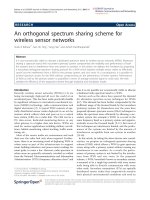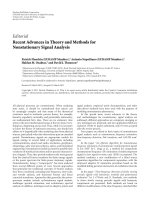Báo cáo hóa học: "Editorial Advances in Propagation Modeling for Wireless Systems" pptx
Bạn đang xem bản rút gọn của tài liệu. Xem và tải ngay bản đầy đủ của tài liệu tại đây (424.61 KB, 2 trang )
Hindawi Publishing Corporation
EURASIP Journal on Wireless Communications and Networking
Volume 2009, Article ID 415736, 2 pages
doi:10.1155/2009/415736
Editorial
Advances in Propagation Modeling for Wireless Systems
Claude Oestges,
1
Michael Jensen,
2
Persefoni Kyritsi,
3
Mansoor Shafi,
4
and Jun-ichi Takada
5
1
Microwave Laboratory, Universit
´
e catholique de Louvain, 1348 Louvain-la-Neuve, Belgium
2
Department of Electrical and Computer Engineering, Brigham Young University, Provo, UT 84602, USA
3
Antennas, Propagation and Radio Networking Section, Aalborg University, 9100 Aalborg, Denmar k
4
Telecom New Zealand, P. O. Box 293, Wellington, New Zealand
5
Department of International Development Engineering, Graduate School of Science and Engineering, Tokyo Institute of Technology,
Meguro-ku, Tokyo 152-8550, Japan
Correspondence should be addressed to Claude Oestges,
Received 18 March 2009; Accepted 18 March 2009
Copyright © 2009 Claude Oestges et al. This is an open access article distributed under the Creative Commons Attribution
License, which permits unrestricted use, distr ibution, and reproduction in any medium, provided the original work is properly
cited.
Advanced wireless systems face an e ver-increasing num-
ber of challenges, such as the limited availability of the
radio frequency spectrum and the demand for faster data
transmissions, better quality of service, and higher network
capacity. Yet, the true challenge faced by new communication
technologies is to achieve the expected performance in real-
world wireless channels. System designers classically focus
on the impact of the radio channel on the received signals
and use propagation models for testing and evaluating
receiver designs and transmission schemes. The needs for
such models evolve as new applications emerge with different
bandwidths, terminal mobility, higher carrier frequencies,
new antennas, and so forth. Furthermore, channel char-
acterization also yields the fundamental ties to classical
electromagnetics and physics as well as the answers to some
crucial questions in communication and information theory.
In particular, it is of outstanding importance for designing
transmission schemes which are efficient in terms of power
or spectrum management. Advanced channel modeling is
also recognized as a major topic by two on-going research
programs in Europe: the Network of Excellence in Com-
munications NEWCOM++ and the European COST 2100
Action “Pervasive Mobile & Ambient Wireless Communica-
tions.” While the former only includes a number of European
partners (see the latter is
a large network of coordinated national research projects in
the fields of interest to participants coming from different EU
and non-EU countries (see />The objective of this special issue, published following
an initiative by NEWCOM++ and COST 2100 partners,
is to highlight the most recent advances in the area of
propagation measurement and modeling. We received 25
high-quality submissions, which were peer-reviewed by
experts in the field, and we selected 9 papers for inclusion
in this special issue. These articles cover the gamut from
electromagnetic models to experimental characterizations of
complex environments as well as the measurement-based
parameterization and analysis of geometry-based stochastic
models.
Three papers deal with the modeling of complex media
or environments. One of the challenges of emerging or future
technologies is indeed the large v ariety of application scenar-
ios, for which classical models might not apply. Furthermore,
more and more techniques rely on adaptive and/or multiple
antenna signal processing, so that the dynamic and spatial
behaviors of the propagation channel should be covered as
well.
The paper by Molina-Garcia-Pardo et al. proposes the
experimental characterization and modeling of propaga-
tion in tunnels, at various frequencies in the 2.8–5 GHz
band. Path loss, large-scale correlation, and fading statistics
are derived from measurements conducted by means of
a vector network analyzer. It is shown that the tunnel
behaves as a low-loss waveguide, and the fading is strongly
dependent on the distance. An extension to a multiple-
input multiple-output (MIMO) channel model is also
presented.
The paper by Moraitis et al. presents experimental results
related to the propagation inside a passenger aircraft, at
various frequencies between 1.8 and 2.45 GHz. Empirical
2 EURASIP Journal on Wireless Communications and Networking
formulas are inferred for the path loss, slow- and fast-
fading, and interference modeling. A comparison with a
physical-optics-based ray-tracing model is also successfully
conducted.
The paper by Cheffena and Ekman combines fading
measurements from 2.45 up to 60 GHz with wind speed
data to study the dynamic effects of swaying vegetation
on radiowave propagation. A simulation model based on a
multiple mass-spring system is developed and empirically
validated. The outputs of the model are the fading first- and
second-order statistics.
Two papers cover the area of physical models. Physi-
cal models traditionally consist of electromagnetic theory
combined with engineering expertise that allows making
reasonable assumptions about the propagation mechanisms
involved. Provided that the correct propagation phenomena
are identified, such theoretical models are capable of making
very accurate predictions in a deterministic manner. The
output being specific to particular locations rather than
being an average value, the model can be applied to very
wide ranges of system and environment parameters, certainly
well beyond the range within which measurements have
been made. The two drawbacks of such models are the
computational effort and the required accuracy of the
geometrical and electrical properties of the environment.
These two issues are dealt with by the following papers.
The paper by Jemai and K
¨
urner investigates the per-
formance boundaries of a calibrated ray-tracing model
in indoor scenarios. It is indeed well known that the
precision of ray-tracing tools is limited by the accuracy
of the environmental description. The proposed approach
improves the prediction accuracy by means of a calibration
procedure, whose sensitivity is further analyzed in the paper.
The paper by Valcarce et al. applies a finite-difference
time-domain (FDTD) method in the framework of WiMAX
femtocells. Two optimization methods are proposed to tackle
the issue of computational complexity. Calibration is also
carried out. The paper eventually presents mobile WiMAX
system-level simulations that make use of the developed
model.
Finally, the last set of papers deals with geometry-based
models for MIMO systems. In geometr ical channel models,
the channel impulse response is related to the location of
scatterers, the location of which is chosen stochastically. A
further important generalization is the existence of multiple
clusters of scatterers. Geometry-based models emulate the
physical reality and thus reproduce many effects implicitly:
small-scale fading, correlation of the signals at different
antenna elements, and even large-scale changes of delays
and directions. Due to the close relationship with physical
reality, it is also relatively easy to parameterize that model, for
example, from measurement results. In a first step, the matrix
impulse responses a re measured with a channel sounder.
High-resolution algorithms are then employed to extract the
required information.
Two papers deal with multipath clustering. The paper by
Czink et al. presents the so-called Random-Cluster Model,
which is a stochastic time-variant frequency-selective MIMO
channel model directly parameterized from experimental
data. A fully automated clustering algorithm is used to
identify multipath clusters which define the model. The
approach is then validated based on different metrics applied
to indoor data.
The paper by Materum et al. presents a methodology
to identify multipath clusters in an automatic way. The
approach is then applied to the clustering at the mobile
station in small urban macrocell at 4.5 GHz. Each identified
cluster is manually confronted with its physical counterpar t,
and conclusive results are drawn on the various propagation
mechanisms.
The last paper on geometry-based modeling by Zhang
et al. investigates several possible simplifications of geom-
etry-based models in view of reducing their complexity
without compromising their accuracy. The analysis relies
on simulation and experimental results and a number of
metrics.
Finally, the paper by Sivasondhivat et al. focuses on
the modeling of the double-directional power spectrum in
urban macrocells when considering dual-polarized MIMO
transmissions. In particular, the separability of the power
spectrum between the base station and the mobile is
investigated, and a model is proposed and validated, based
on the sum of polarization pairwise Kronecker product
approximation.
Acknowledgments
We would like to take this opportunity to express our sincere
thanks to the authors for contributing to this special issue
and to the reviewers for providing prompt and detailed
remarks that helped improve the quality of the manuscripts.
We also wish to thank the Editor-in-Chief and the editorial
office for their support through the entire editing process.
Finally, C. Oestges acknowledges the contribution of the
European Commission through the FP7 research program
(European Network of Excellence NEWCOM++, which
started in January 2008 for a period of 3 years). C. Oestges
and J-i. Takada are also members of the European COST
2100 Action.
Claude Oestges
Michael Jensen
Persefoni Kyritsi
Mansoor Shafi
Jun-ichi Takada









